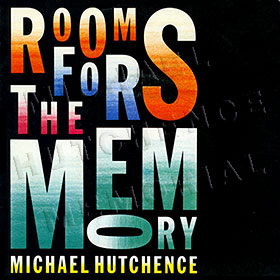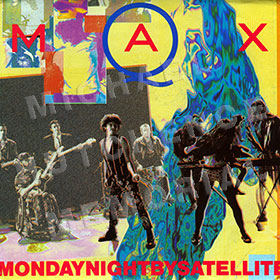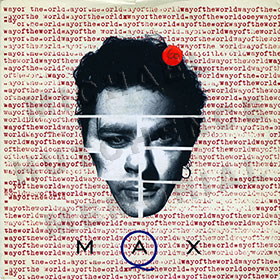By Dan Jones

Tracklist
Produced by Michael Hutchence and Ollie Olsen
Co-Written by Michael Hutchence*
Vocals by Michael Hutchence
Sometimes [5:31]
Way Of The World [4:05]
Ghost of the Year [4:16]
Everything* [4:48]
Concrete* [5:13]
Zero 2 0* [1:33]
Soul Engine* [3:50]
Buckethead [4:00]
Monday Night by Satellite [3:34]
Tight* [3:38]
Ot-Ven-Rot* [5:17]
Sometimes (Rock House Extended – Japan Only) [5:45]
Way Of The World (12″ Mix – Japan Only) [4:37]
Zero-2-O (Todd Terry Mix – Japan Only) [4:20]
Ghost Of The Year (Todd Terry Mix – Japan Only) [4:23]
In 1989, an interesting change of pace for watchers of INXS came in the form of a collaborative album involving Michael Hutchence and Ollie Olsen. Olsen, ex-Whirlywirld mastermind, and a Melbourne-based musician and DJ of some repute, had worked with Michael on music for the Richard Lowenstein film Dogs In Space a couple of years before, and scored an Australian hit with the alluring track ‘Rooms For The Memory’ (from the film and soundtrack LP). Dubbed Max Q (after Ollie’s dog of the same name), the band consisted of mainstays Olsen and Hutchence with an attachment mob of musicians drawn from the underground scene.

Held in high regard by fans and critics alike, but unsuccessful commercially, Max Q is a remarkable album indeed. Considered ahead of its time upon release and now out of print (when it could be most appreciated); Max Q deserves some long overdue attention. Constructed around Olsen’s hybrid electronic song structures, Max Q explodes with invention at every turn. ‘Sometimes’ and ‘Way Of The World’, both featured tracks on the album, bristle with a vibe of punk/agro meets disco/house splendor – an area bands like Depeche Mode and Massive Attack have explored in depth. Jittery guitars clash with looped percussion attacks, and Michael’s raging vocal workouts head butt powerful orchestral flourishes and the odd sonic bleep. There’s a lot of raw noise going on here, but some of it is certainly beautiful – i.e. ‘Monday Night By Satellite’ and ‘Ot-Ven-Rot’. Faint traces of Talking Heads, Eastern influences and the specter of Barry White also frame this exciting music.
In addition to Hutchence and Olsen, the rest of the players on Max Q are:
Arnie Hanna: Guitar
Michael Sheridan: Guitar, Feedback
Bill McDonald: Bass Guitar
Gus Till: Piano, MID Programming
John Murphy: Percussion, Trumpet, Screams
Peggy Harley: Backing Vocals
Marie Hoy: Backing Vocals (Soul Engine)
Pat Powell: Backing Vocals (Bucket Head)
Pam Ross: Narration
Strings written and arranged by Frank Millward and Ollie Olsen
Violins: Phillip Hartl (Leader), Martin Silverton, Mirka Rozmus, Isabel Morse, Maja Verunica, Nadia Kelvin
Cellos: Anthony Morgan, Trish Ayling, Heather Keens
Copyist: Chris Cunningham
 Before the release of the album the Australian master tapes were taken to New York City to be given a further polishing in the mix department by genius musical innovator Todd Terry from Chicago. A famous DJ who is one of the founding fathers of House music, Terry worked on the album and the attendant remixes (issued as b-sides and bonus tracks around the world). Michael and Ollie accompanied the movement of the music to NYC, and rooming together on the upper west side of town, finished the record and set plans and strategies into place for its release, promo and publicity.
Before the release of the album the Australian master tapes were taken to New York City to be given a further polishing in the mix department by genius musical innovator Todd Terry from Chicago. A famous DJ who is one of the founding fathers of House music, Terry worked on the album and the attendant remixes (issued as b-sides and bonus tracks around the world). Michael and Ollie accompanied the movement of the music to NYC, and rooming together on the upper west side of town, finished the record and set plans and strategies into place for its release, promo and publicity.
Upon release, Max Q would go through the Atlantic (WEA) pipeline stateside for the albums distribution, Mercury in the UK and Europe, and CBS/Sony in Australia. Coming on the heels of INXS’s triumphant KICK album and tour didn’t hurt, but also did not guarantee attention in the marketplace or translate to sales necessarily. Both of those areas suffered as far as Max Q was concerned – not for lack of trying though. With an intriguing Richard Lowenstein concept video for ‘Way Of The World’, and a mad dancing workout performance clip for ‘Sometimes’, exposure on music video channels globally was assured. Another little-seen (but highly innovative) video for third single ‘Monday Night By Satellite’ was also created and issued in some territories outside the US. Sadly, Max Q was doomed without 100% commitment from all participants (musicians, managers, etc.) and enough touring to make a difference (there were no Max Q live dates).
Max Q Endgame
In the context of INXS, Max Q draws insights into Michael’s musical leanings away from the powerful funk/rock super band. An artistic triumph, the special album project established Michael Hutchence as no mere ‘hood ornament’ fronting a globe-trotting pop group (witness his understated presence on the mosaic-like cover image and associated band photos). This was not a typical vanity trip by a rich rock star and his cronies by any means – quite the opposite. Even the provocative shearing of his golden locks into a smart “short, back and sides” cut further distanced the Michael of Max Q and INXS.
 In hindsight, Max Q proved to be a worthwhile side project that had a positive creative impact on INXS when they reconvened to record X in 1990, and future recordings throughout the next decade. One can hear the Max Q influence on INXS in songs such as ‘Faith In Each Other’, ‘Strange Desire’, ‘The Gift’ and ‘She Is Rising’. Interestingly, the b-side to the band’s very next single, ‘Suicide Blonde’ (after Max Q was released), a sassy track called ‘Everybody Wants U Tonight’ by Jon Farriss, bears a strong likeness to the Max Q material, showing that Michael was not the only one exploring new musical areas within the band at this time.
In hindsight, Max Q proved to be a worthwhile side project that had a positive creative impact on INXS when they reconvened to record X in 1990, and future recordings throughout the next decade. One can hear the Max Q influence on INXS in songs such as ‘Faith In Each Other’, ‘Strange Desire’, ‘The Gift’ and ‘She Is Rising’. Interestingly, the b-side to the band’s very next single, ‘Suicide Blonde’ (after Max Q was released), a sassy track called ‘Everybody Wants U Tonight’ by Jon Farriss, bears a strong likeness to the Max Q material, showing that Michael was not the only one exploring new musical areas within the band at this time.
 A must-have item in any comprehensive INXS collection, Max Q also connects in a very linear way with the Michael Hutchence solo album released in 1999 (U.S., 2000). Though Ollie Olsen is not part of that new album’s makeup, the style is similar in its assimilation of current left-field influences and odd recording approaches and performances. The biographical aspects of both records cannot be ignored either. ‘Possibilities’ from the posthumous solo album echoes sentiments of ‘Concrete’ from Max Q, and so on. In essence, Max Q was Michael’s first solo album, but to his credit he went to great lengths to establish it very much as a freestanding band apart from ‘Michael Hutchence of INXS,’ allowing for the project to stand or fall on its own merits.
A must-have item in any comprehensive INXS collection, Max Q also connects in a very linear way with the Michael Hutchence solo album released in 1999 (U.S., 2000). Though Ollie Olsen is not part of that new album’s makeup, the style is similar in its assimilation of current left-field influences and odd recording approaches and performances. The biographical aspects of both records cannot be ignored either. ‘Possibilities’ from the posthumous solo album echoes sentiments of ‘Concrete’ from Max Q, and so on. In essence, Max Q was Michael’s first solo album, but to his credit he went to great lengths to establish it very much as a freestanding band apart from ‘Michael Hutchence of INXS,’ allowing for the project to stand or fall on its own merits.